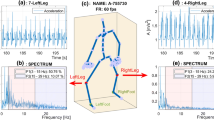Abstract
Rapid aging of the population of the developed countries could exceed the society’s capacity for taking care for them. In order to help solving this problem, we propose a system for automatic discovery of health problems from motion-capture data of gait of elderly. The gait of the user is captured with the motion capture system, which consists of tags attached to the body and sensors situated in the apartment. Position of the tags is acquired by the sensors and the resulting time series of position coordinates are analyzed with machine learning algorithms in order to identify the specific health problem. We propose novel features for training a machine learning classifier that classifies the user’s gait into: i) normal, ii) with hemiplegia, iii) with Parkinson’s disease, iv) with pain in the back and v) with pain in the leg. Results show that naive Bayes needs more tags and less noise to reach classification accuracy of 98 % than support vector machines for 99 %.
Access this chapter
Tax calculation will be finalised at checkout
Purchases are for personal use only
Preview
Unable to display preview. Download preview PDF.
Similar content being viewed by others
References
D. Strle, V. Kempe, “MEMS-based inertial systems”, Informacije MIDEM 37(2007)4, pp. 199-209.
D. Jurman, M. Jankovec, R. Kamnik, M. Topič, “Inertial and magnetic sensors: The calibration aspect”, Informacije MIDEM 37(2007)2, pp. 67-72.
F. Dimic, B. Mušič, R. Osredkar, “An example of an integrated GPS and DR positioning system designed for archeological prospecting”, Informacije MIDEM 38(2008)2, pp. 144-148.
S. Ribarič, J. Rozman, “Sensors for measurement of tremor type joint movements”, Informacije MIDEM 37(2007)2, pp. 98-104.
J. Trontelj, J. Trontelj and L. Trontelj, “Safety Margin at mammalian neuromuscular junction – an example of the significance of fine time measurements in neurobiology”, Informacije MIDEM 38(2008)3, pp. 155-160.
Bourke, A.K., and Lyons, G.M. A threshold-based fall-detection algorithm using a bi-axial gyroscope sensor. Medical Engineering & Physics 30, 1 (2006), 84–90.
Bourke, A.K., Scanaill, C.N., Culhane, K.M., O'Brien, J.V., and Lyons, G.M. An optimum accelerometer configuration and simple algorithm for accurately detecting falls. In Proc. BioMed 2006 (2006), 156–160.
Confidence: Ubiquitous Care System to Support Independent Living. http://www.confidenceeu.org.
Craik R., and Oatis C. Gait Analysis: Theory and Application. Mosby-Year Book (1995).
Perry J. Gait Analysis: Normal and Pathological Function. McGraw-Hill, Inc., 1992.
eMotion. Smart motion capture system. http://www.emotion3d.com/smart/smart.html.
Kangas, M., Konttila, A., Lindgren, P., Winblad, P., and Jamsa, T. Comparison of lowcomplexity fall detection algorithms for body attached accelerometers. Gait & Posture 28, 2 (2008), 285–291.
Lakany, H. Extracting a diagnostic gait signature. Pattern recognition 41 (2008), 1627–1637.
Luštrek M., Kaluža B., Fall Detection and Activity Recognition with Machine Learning. Informatica (Slovenia) 33(2): 197-204 (2009).
Maybeck, P.S. Stochastic models, estimation, and control. Mathematics in Science and Engineering 141 (1979).
Qian, G., Guo, F., Ingalls, T., Olson, L., James, J., and Rikakis, T. A gesture-driven multimodal interactive dance system. In Proc. ICME ’04 (2004), 1579–1582.
Sukthankar, G., and Sycara, K. A cost minimization approach to human behavior recognition. In Proc. AAMAS 2005 (2005), 1067–1074.
Tapia, E.M., Intille, S.S., Haskell, W., Larson, K., Wright, J., King, A., and Friedman, R. Real-time recognition of physical activities and their intensities using wireless accelerometers and a heart rate monitor. In Proc. ISWC 2007 (2007), 37–40.
Vishwakarma, V., Mandal, C., and Sura, S. Automatic detection of human fall in video. Lecture Notes in Computer Science 4815 (2007), 616–623.
Witten, I.H., and Frank, E. Data Mining: Practical Machine Learning Tools and Techniques (2nd edition). Morgan Kaufmann (2005).
Zhang, T., Wang, J., Liu, P., and Hou, J. Fall detection by wearable sensor and One-Class SVM algorithm. Lecture Notes in Control and Information Science 345 (2006), 858–863.
Zouba, N., Boulay, B., Bremond, F., and Thonnat, M. Monitoring activities of daily living (ADLs) of elderly based on 3D key human postures. In Proc. ICVW 2008 (2008), 37–50.
Moore ST, et al., Long-term monitoring of gait in Parkinson’s disease, Gait Posture (2006), doi:10.1016/j.gaitpost.2006.09.011
Acknowledgments
This work is partially financed by the European Union, the European Social Fund. The authors thank Martin Tomšič, Bojan Nemec and Leon Žlajpah for their help with data acquisition, Anton Gradišek for his medical expertise and Zoran Bosnić and Mitja Luštrek for helpful discussions.
Author information
Authors and Affiliations
Corresponding authors
Editor information
Editors and Affiliations
Rights and permissions
Copyright information
© 2011 Springer-Verlag London Limited
About this paper
Cite this paper
Pogorelc, B., Gams, M. (2011). Health Problems Discovery from Motion-Capture Data of Elderly. In: Bramer, M., Petridis, M., Hopgood, A. (eds) Research and Development in Intelligent Systems XXVII. SGAI 2010. Springer, London. https://doi.org/10.1007/978-0-85729-130-1_28
Download citation
DOI: https://doi.org/10.1007/978-0-85729-130-1_28
Published:
Publisher Name: Springer, London
Print ISBN: 978-0-85729-129-5
Online ISBN: 978-0-85729-130-1
eBook Packages: Computer ScienceComputer Science (R0)





